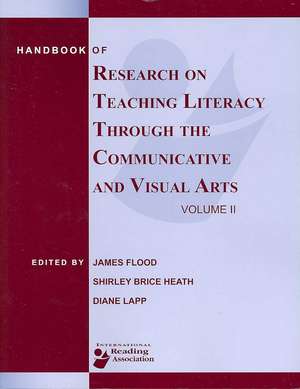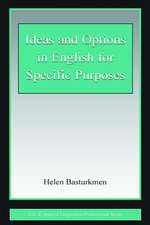Handbook of Research on Teaching Literacy Through the Communicative and Visual Arts, Volume II: A Project of the International Reading Association
Autor James Flood, Shirley Brice Heath, Diane Lappen Limba Engleză Paperback – 26 dec 2007
A project of the International Reading Association, published and distributed by Routledge/Taylor & Francis. Visit http://www.reading.org for more information about Internationl Reading Associationbooks, membership, and other services.
Preț: 754.32 lei
Preț vechi: 1122.71 lei
-33% Nou
Puncte Express: 1131
Preț estimativ în valută:
144.35€ • 149.85$ • 120.37£
144.35€ • 149.85$ • 120.37£
Carte tipărită la comandă
Livrare economică 22 martie-05 aprilie
Preluare comenzi: 021 569.72.76
Specificații
ISBN-13: 9780805857009
ISBN-10: 0805857001
Pagini: 628
Dimensiuni: 210 x 280 x 33 mm
Greutate: 1.45 kg
Ediția:1
Editura: Taylor & Francis
Colecția Routledge
Locul publicării:Oxford, United Kingdom
ISBN-10: 0805857001
Pagini: 628
Dimensiuni: 210 x 280 x 33 mm
Greutate: 1.45 kg
Ediția:1
Editura: Taylor & Francis
Colecția Routledge
Locul publicării:Oxford, United Kingdom
Public țintă
PostgraduateCuprins
Preface. R. Hobbs, Part 1: Historical and Theoretical Foundations. Introduction to Part 1. S.B. Heath, R. Wollach, Vision for Learning: History, Theory, and Affirmation. D.L. Bruce, Multimedia Production as Composition. D. Felini, Crossing the Bridge: Literacy Between School and Contemporary Culture. A.L. Mendelson, The Construction of Photographic Meaning. S.E. Woodson, Constructing, Performing, and Reading Representations of Youth and Childhood. C. Bazalgette, The Development of Media Education in England. C. Brock, R. Case, J. Pennington, G. Li, R. Salas, Using a Multimodal Theoretical Lens to Explore Studies Pertaining to English Learners in the Visual and Communicative Arts. N. Frey, Censorship and Censorship Policy: The Impact on Teaching Literacy Through the Visual Arts. R. Valtin, C. Roller, J. Else, How International Assessments Contribute to Policy Analysis. Voices From the Field: A. Michel, K. Slack, Mastering the Media: A Practitioner’s View. E.Y. Rosen, E. Deiparine-Sugars, Unexpected Outcomes of Media Arts Education. D. Alvermann, M. Hagood, L. Rush, Part 2: Methods of Inquiry in the Communicative, Visual, and Performative Arts. Introduction to Part 2. G. Kress, ‘Literacy’ in a Multimodal Environment of Communication. R.J. Tierney, Learning With Multiple Literacies: Observations of Lives Exploring Meanings, Identities, Possibilities, and Worlds. A.H. Dyson, Children Out of Bounds: The Power of Case Studies in Expanding Visions of Literacy Development. S.Z. Athanases, Theatre and Theory Partnered Through Ethnographic Study. C.C. Pappas, Making “Collaboration” Problematic in Collaborative School-University Action Research: Studying With Urban Teacher Researchers to Transform Literacy Practices. L. Neilsen, Remaking Sense, Reshaping Inquiry: Feminist Metaphors and a Literacy of the Possible. S.J. Miller, (Re)Re-envisioning Preservice Teacher Identity: Matrixing Methodology. J. Cheville, Analytic Dilemmas in Real and Virtual Contexts: A Turn to Spatial Semiosis. K. Tisdale, Disability Studies Matters. A.J. Eakle, Museum Literacy, Art, and Space Study. L. Vasudevan, "A Picture Can Do Things Words Can't": Transforming Representations in Literacy Research. B. Kapinus, C. Roller, Literacy Research and Policy: Are We Learning Anything? Voices From the Field: A. Brandenberg, Music in a Child’s Life. V. Chou, P. Konkol, Part 3: Family and Community Contexts in the Communicative, Visual, and Performative Arts. Introduction to Part 3. E.B. Moje, Youth Literacies, Identities, and Cultures in and out of School. JE. Fisherkeller, A World of Expanding Literacies: Audio-Visual and Non-Linear Digital Forms in Everyday Life. M. Bitz, The Comic Book Project: Literacy Outside (and Inside) the Box. C. Lewis, Internet Communication Among Youth: New Practices and Epistemologies. K. Chandler-Olcott, Anime and Manga Fandom: Young People's Multiliteracies Made Visible. K. Sheridan, Reading, Writing, and Watching: The Informal Education of Film Fans. E. Soep, Working the Crowd: Youth Media Interactivity. J. Mahiri, M. Ali, A.L. Scott, B. Asmerom, R. Ayers, Both Sides of the Mic: Community Literacies in the Age of Hip Hop. C. Worthman, Novelness in Action: The Role of Self-Generated Dramatic Arts Activities in the Literacy Development of Adolescents. Y.J. Majors, “We as Stylist Actually Become Like Psychiatrists:” Problem-Solving in Public Performance. D.M. Piano, Exchanging Life Narratives: The Politics and Poetics of Do-It-Yourself Practices. G.M.T. McMillon, P.A. Edwards, Examining Shared Domains of Literacy in the Church and School of African-American Children. I. Pumpian, D. Fisher, Violence and the Visual, Performing, and Communicate Arts: What Do We Know? Voices From the Field: S.D. Collins,
Awakening Voice and Losing Sleep: When Adult Southern Learners Become Writers. C. Gilrane, Picture Book Biographies to Promote Intercultural Understanding. N. Roser, D. Strickland, Part 4: Into the Language Arts Classroom Through the Visual and Communicative Arts. Introduction to Part 4. R. Bomer, Literacy Classrooms: Making Mind out of Multimodal Material. E. Arizpe, M. Styles, A Critical Review of Research Into Children's Responses to Multimodal Texts. B. Kiefer, Reading the Art of the Picturebook. L. Sipe, Young Children's Visual Meaning-Making in Response to Picture Books. B. Moss, Getting the Picture: Visual Dimensions of Informational Texts. A. McGill-Franzen, J.L. Zeig, Drawing to Learn: Visual Support for Developing Reading, Writing, and Concepts for Children At-Risk. M. Massie, K. Boran, J.D. Wilhelm, The Role Visualization Strategies Play in Struggling Readers' Engagement, Comprehension, and Responses to Text or "Wait. You Mean It's Supposed to Make Sense Every Time You Read?” K. Bromley, From Drawing to Digital Creations: Graphic Organizers in the Classroom. B.R. Robin, The Effective Uses of Digital Storytelling as a Teaching and Learning Tool. S.M. Miller, Teacher Learning for New Times: Repurposing New Multimodal Literacies and Digital Video Composing for Schools. L.Galda, A.D. Pellegrini, Dramatic Play and Dramatic Activity: Literate Language and Narrative Understanding. A.H. Dyson, Playing With Textual Toys: Popular Culture and Childhood Writing. M.C. Alvarez, V.J. Risko, Promoting Self-Knowledge: Adolescents Engaged in Educating. P.U. Brown, G. Schwarz, Critical Media Literacy in Secondary Schools. J.L. Wolf, Wanting to Look a Thousand Times: Blending Visual and Textual Elements in the Contemporary Young Adult Novel. J.T. Pham, A.A. Lunsford, Shakespeare and Gaiman: Strange Bedfellows Attain Immortality. L. Baines, Film, Literature, and Language. J. Trier, Media Over the Decades: FromRadio (Fast-Forward) to iPod. W. Kist, Film and Video in the Classroom: Back to the Future. J. Marsh, Popular Culture in the Language Arts Classroom. D. Lapp, J. Flood, K. Moore, Differentiating Visual, Communicative, and Performative Arts Instruction in Well Managed Classrooms. Voices From the Field. M. Bang, Pictures as Part of a Normal School Day: Third Grade. J. Yolen, An Eruption of Poppies: A Meditation on Writing Landscape. E.T. Sullivan, The Truth About Nonfiction. D.A. Wooten, Timeless Timeline: Visualizing the Past and the Future. N.L. McDonald, Standards in the Arts: Initial Questions About Arts Within Literacy Instruction. J. Greenberg, Encounters With Art in and out of the Classroom.
Awakening Voice and Losing Sleep: When Adult Southern Learners Become Writers. C. Gilrane, Picture Book Biographies to Promote Intercultural Understanding. N. Roser, D. Strickland, Part 4: Into the Language Arts Classroom Through the Visual and Communicative Arts. Introduction to Part 4. R. Bomer, Literacy Classrooms: Making Mind out of Multimodal Material. E. Arizpe, M. Styles, A Critical Review of Research Into Children's Responses to Multimodal Texts. B. Kiefer, Reading the Art of the Picturebook. L. Sipe, Young Children's Visual Meaning-Making in Response to Picture Books. B. Moss, Getting the Picture: Visual Dimensions of Informational Texts. A. McGill-Franzen, J.L. Zeig, Drawing to Learn: Visual Support for Developing Reading, Writing, and Concepts for Children At-Risk. M. Massie, K. Boran, J.D. Wilhelm, The Role Visualization Strategies Play in Struggling Readers' Engagement, Comprehension, and Responses to Text or "Wait. You Mean It's Supposed to Make Sense Every Time You Read?” K. Bromley, From Drawing to Digital Creations: Graphic Organizers in the Classroom. B.R. Robin, The Effective Uses of Digital Storytelling as a Teaching and Learning Tool. S.M. Miller, Teacher Learning for New Times: Repurposing New Multimodal Literacies and Digital Video Composing for Schools. L.Galda, A.D. Pellegrini, Dramatic Play and Dramatic Activity: Literate Language and Narrative Understanding. A.H. Dyson, Playing With Textual Toys: Popular Culture and Childhood Writing. M.C. Alvarez, V.J. Risko, Promoting Self-Knowledge: Adolescents Engaged in Educating. P.U. Brown, G. Schwarz, Critical Media Literacy in Secondary Schools. J.L. Wolf, Wanting to Look a Thousand Times: Blending Visual and Textual Elements in the Contemporary Young Adult Novel. J.T. Pham, A.A. Lunsford, Shakespeare and Gaiman: Strange Bedfellows Attain Immortality. L. Baines, Film, Literature, and Language. J. Trier, Media Over the Decades: FromRadio (Fast-Forward) to iPod. W. Kist, Film and Video in the Classroom: Back to the Future. J. Marsh, Popular Culture in the Language Arts Classroom. D. Lapp, J. Flood, K. Moore, Differentiating Visual, Communicative, and Performative Arts Instruction in Well Managed Classrooms. Voices From the Field. M. Bang, Pictures as Part of a Normal School Day: Third Grade. J. Yolen, An Eruption of Poppies: A Meditation on Writing Landscape. E.T. Sullivan, The Truth About Nonfiction. D.A. Wooten, Timeless Timeline: Visualizing the Past and the Future. N.L. McDonald, Standards in the Arts: Initial Questions About Arts Within Literacy Instruction. J. Greenberg, Encounters With Art in and out of the Classroom.
Notă biografică
James Flood, Shirley Brice Heath, Diane Lapp
Descriere
The Handbook of Research on Teaching Literacy Through the Communicative and Visual Arts, Volume II brings together state-of-the-art research and practice on the evolving view of literacy as encompassing not only reading, writing, speaking, and listening, but also the multiple ways through which learners gain access to knowledge and skills.

